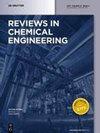Fischer-Tropsch合成固定床和淤浆鼓泡塔反应器的建模
IF 6.6
3区 工程技术
Q1 ENGINEERING, CHEMICAL
引用次数: 0
摘要
摘要本文对费托合成中浆态泡塔反应器和固定床反应器稳态模型进行了综述。材料、能量和动量平衡方程在此连同每项研究的相关发现一起提出,以供建模之用。对于固定床反应器模型,可以区分一维模型和二维模型,二维模型在预测热点和热失控方面更好,但求解它们所需的计算量也更高。固定床反应器也可以分为准均相或非均相模型,前者考虑到所有相都处于热和化学平衡状态,后者对催化剂颗粒具有不同的分布,通常包括球团模型。浆液泡塔反应器可分为单级泡模型和双级泡模型。双类气泡模型以更高的计算量为代价,表现出更好的搅动-湍流状态。本文章由计算机程序翻译,如有差异,请以英文原文为准。
Modelling of fixed bed and slurry bubble column reactors for Fischer–Tropsch synthesis
Abstract An extensive review of slurry bubble column reactor and fixed bed reactor steady state models for Fischer–Tropsch synthesis is presented in this work. Material, energy and momentum balance equations are presented here along with the relevant findings of each study for modelling purposes. For fixed bed reactor models, one-dimensional and two-dimensional models can be differentiated, with the latter being better at predicting hot spots and thermal runaways, although the computational effort required solving them is also higher. Fixed bed reactors can also be classified as pseudo-homogeneous or heterogeneous models, the former considering that all phases are in thermal and chemical equilibrium, and the latter having different profiles for the catalyst particles, generally including a pellet model. For slurry bubble column reactors, single-class and double-class bubble models can be differentiated. The double-class bubble models represent better churn-turbulent regimes at the expense of a higher computational effort.
求助全文
通过发布文献求助,成功后即可免费获取论文全文。
去求助
来源期刊

Reviews in Chemical Engineering
工程技术-工程:化工
CiteScore
12.30
自引率
0.00%
发文量
37
审稿时长
6 months
期刊介绍:
Reviews in Chemical Engineering publishes authoritative review articles on all aspects of the broad field of chemical engineering and applied chemistry. Its aim is to develop new insights and understanding and to promote interest and research activity in chemical engineering, as well as the application of new developments in these areas. The bimonthly journal publishes peer-reviewed articles by leading chemical engineers, applied scientists and mathematicians. The broad interest today in solutions through chemistry to some of the world’s most challenging problems ensures that Reviews in Chemical Engineering will play a significant role in the growth of the field as a whole.
 求助内容:
求助内容: 应助结果提醒方式:
应助结果提醒方式:


